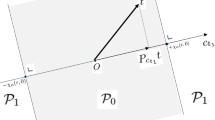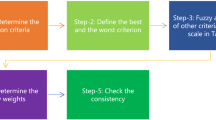Abstract
An adaptive Bayesian polynomial chaos expansion (BPCE) is developed in this paper for uncertainty quantification (UQ) and reliability analysis. The sparsity in the PCE model is developed using automatic relevance determination (ARD) and the PCE coefficients are computed using the variational Bayesian (VB) inference. Further, Sobol sequence is utilized to evaluate a response quantity sequentially. Finally, leave one out (LOO) error is used to obtain the adaptive BPCE model. UQ and reliability analysis are performed of some numerical examples by the adaptive BPCE model. It is found that the optimal number of model evaluations and the optimal PCE degree are suitably selected simultaneously for a problem by the adaptive BPCE model. A highly accurate result is predicted by the proposed approach using very few model evaluation. Further, highly sparse PCE models are obtained by the ARD approach for most of the numerical examples. Additionally, distribution parameters of the predicted response quantity are also obtained by the VB inference, which are used to compute the confidence interval of the predicted response quantities.

















Similar content being viewed by others
References
Abdollahi A, Azhdary Moghaddam M, Hashemi Monfared SA, Rashki M, Li Y (2020) Subset simulation method including fitness-based seed selection for reliability analysis. Eng Comput 1–17. https://doi.org/10.1007/s00366-020-00961-9
Abraham S, Tsirikoglou P, Miranda J, Lacor C, Contino F, Ghorbaniasl G (2018) Spectral representation of stochastic field data using sparse polynomial chaos expansions. J Comput Phys 367:109–120
Au SK, Beck JL (2001) Estimation of small failure probabilities in high dimensions by subset simulation. Probab Eng Mech 16(4):263–277
Bhattacharyya B (2018) A critical appraisal of design of experiments for uncertainty quantification. Arch Comput Methods Eng 25(3):727–751
Bhattacharyya B (2020) Global sensitivity analysis: a Bayesian learning based polynomial chaos approach. J Comput Phys 415(109539):1–22
Bhattacharyya B, Jacquelin E, Brizard D (2019) Uncertainty quantification of nonlinear stochastic dynamic problem using a Kriging-NARX surrogate model. In: 3rd International conference on uncertainty quantification in computational sciences and engineering, pp 34–46. Crete, Greece
Bhattacharyya B, Jacquelin E, Brizard D (2020) A Kriging-NARX model for uncertainty quantification of nonlinear stochastic dynamical systems in time domain. J Eng Mech 146(7):1–21
Bhattacharyya B, Jacquelin E, Brizard D (2020) Uncertainty quantification of stochastic impact dynamic oscillator using a proper orthogonal decomposition-polynomial chaos expansion technique. J Vib Acoust 142(6):1–13
Bishop CM (2006) Pattern recognition and machine learning. Springer, New York
Blatman G, Sudret B (2008) Sparse polynomial chaos expansions and adaptive stochastic finite elements using a regression approach. Comptes Rend Méc 336(6):518–523
Blatman G, Sudret B (2011) Adaptive sparse polynomial chaos expansion based on least angle regression. J Comput Phys 230(6):2345–2367
Bourinet JM, Deheeger F, Lemaire M (2011) Assessing small failure probabilities by combined subset simulation and support vector machines. Struct Saf 33(6):343–353
Breitung K, Faravelli L (1994) Log-likelihood maximization and response surface in reliability assessment. Nonlinear Dyn 5(3):273–285
Chapelle O, Vapnik V, Bengio Y (2002) Model selection for small sample regression. Mach Learn 48(1–3):9–23
Cheng K, Lu Z (2018) Adaptive sparse polynomial chaos expansions for global sensitivity analysis based on support vector regression. Comput Struct 194:86–96
Cheng K, Lu Z (2018) Sparse polynomial chaos expansion based on D-MORPH regression. Appl Math Comput 323:17–30
Cheng K, Lu Z, Zhen Y (2019) Multi-level multi-fidelity sparse polynomial chaos expansion based on Gaussian process regression. Comput Methods Appl Mech Eng 349:360–377
Doucet A, Freitas ND, Gordon N (2001) Sequential Monte Carlo methods in practice. Springer, New York
Echard B, Gayton N, Lemaire M (2011) AK-MCS: an active learning reliability method combining Kriging and Monte Carlo Simulation. Struct Saf 33(2):145–154
Efron B, Hastie T, Johnstone I, Tibshirani R (2004) Least angle regression. Ann Stat 32(2):407–499
Fiessler B, Rackwitz R, Neumann HJ (1979) Quadratic limit states in structural reliability. J Eng Mech Div 105(4):661–676
Gaspar B, Teixeira A, Soares CG (2014) Assessment of the efficiency of Kriging surrogate models for structural reliability analysis. Probab Eng Mech 37:24–34
Gavin HP, Yau SC (2008) High-order limit state functions in the response surface method for structural reliability analysis. Struct Saf 30(2):162–179
Gayton N, Bourinet J, Lemaire M (2003) CQ2RS: a new statistical approach to the response surface method for reliability analysis. Struct Saf 25(1):99–121
Griffin JE, Brown PJ (2010) Inference with normal-gamma prior distributions in regression problems. Bayesian Anal 5(1):171–188
Guimarães H, Matos JC, Henriques AA (2018) An innovative adaptive sparse response surface method for structural reliability analysis. Struct Saf 73:12–28
Guo L, Narayan A, Zhou T (2018) A gradient enhanced l1-minimization for sparse approximation of polynomial chaos expansions. J Comput Phys 367:49–64
Hohenbichler M, Rackwitz R (1988) Improvement of second-order reliability estimates by importance sampling. J Eng Mech 114(12):2195–2199
Hosni Elhewy A, Mesbahi E, Pu Y (2006) Reliability analysis of structures using neural network method. Probab Eng Mech 21(1):44–53
Hu C, Youn BD (2010) Adaptive-sparse polynomial chaos expansion for reliability analysis and design of complex engineering systems. Struct Multidiscip Optim 43(3):1–24
Huan X, Safta C, Sargsyan K, Vane ZP, Lacaze G, Oefelein JC, Najm HN (2018) Compressive sensing with cross-validation and stop-sampling for sparse polynomial chaos expansions. SIAM/ASA J Uncertaint Quantif 6(2):907–936
Jacobs WR, Baldacchino T, Dodd TJ, Anderson SR (2018) Sparse Bayesian nonlinear system identification using variational inference. IEEE Trans Autom Control 63(12):4172–4187
Jacquelin E, Baldanzini N, Bhattacharyya B, Brizard D, Pierini M (2019) Random dynamical system in time domain: a POD-PC model. Mech Syst Signal Process 133:106251
Jakeman JD, Eldred MS, Sargsyan K (2015) Enhancing l1-minimization estimates of polynomial chaos expansions using basis selection. J Comput Phys 289:18–34
Jensen JLWV (1906) Sur les fonctions convexes et les inégalités entre les valeurs moyennes. Acta Math 30(1):175–193
Kaymaz I (2005) Application of kriging method to structural reliability problems. Struct Saf 27(2):133–151
Kiureghian AD, Stefano MD (1992) Efficient algorithm for second-order reliability analysis. J Eng Mech 117(12):2904–2923
Li G, Rabitz H (2010) D-morph regression: application to modeling with unknown parameters more than observation data. J Math Chem 48(4):1010–1035
Li X, Gong C, Gu L, Gao W, Jing Z, Su H (2018) A sequential surrogate method for reliability analysis based on radial basis function. Struct Saf 73:42–53
Low BK, Tang WH (2007) Efficient spreadsheet algorithm for first-order reliability method. J Eng Mech 133(12):1378–1387
Mackay DJ (1995) Probable networks and plausible predictions—a review of practical Bayesian methods for supervised neural networks. Network: Computation in Neural Systems 6(3):469-505.
Neal RM, Hinton GE (1998) A view of the EM algorithm that justifies incremental, sparse, and other variants. Learning in graphical models. Springer, Berlin, pp 355–368
Parisi G (1988) Statistical field theory. Addison-Wesley, Boston
Peierls R (1938) On a minimum property of the free energy. Phys Rev 54(11):918–919
Rackwitz R, Fiessler B (1978) Structural reliability under combined random load sequences. Comput Struct 9(5):489–494
Rajashekhar MR, Ellingwood BR (1993) A new look at the response surface approach for reliability analysis. Struct Saf 12(3):205–220
Ross SM (2007) Introduction to probability models, 11th edn. Academic Press, New York
Salehi S, Raisee M, Cervantes MJ, Nourbakhsh A (2018) An efficient multifidelity l1-minimization method for sparse polynomial chaos. Comput Methods Appl Mech Eng 334:183–207
Shao Q, Younes A, Fahs M, Mara TA (2017) Bayesian sparse polynomial chaos expansion for global sensitivity analysis. Comput Methods Appl Mech Eng 318:474–496
Sobol IM (1967) On the distribution of points in a cube and the approximate evaluation of integrals. USSR Comput Math Math Phys 7(4):86–112
Sobol IM (1990) Quasi-Monte Carlo methods. Prog Nucl Energy 24(1–3):55–61
Song K, Zhang Y, Zhuang X, Yu X, Song B (2020) An adaptive failure boundary approximation method for reliability analysis and its applications. Eng Comput 1–16. https://doi.org/10.1007/s00366-020-01011-0
Steiner M, Bourinet JM, Lahmer T (2019) An adaptive sampling method for global sensitivity analysis based on least-squares support vector regression. Reliab Eng Syst Saf 183:323–340
Tripathy RK, Bilionis I (2018) Deep UQ: learning deep neural network surrogate models for high dimensional uncertainty quantification. J Comput Phys 375:565–588
Wang Z, Shafieezadeh A (2019) REAK: reliability analysis through error rate-based adaptive kriging. Reliab Eng Syst Saf 182:33–45
Wipf D, Nagarajan S (2008) A new view of automatic relevance determination. In Advances in neural information processing systems. Springer, New York, pp 1625–1632
Wu Z, Wang W, Wang D, Zhao K, Zhang W (2019) Global sensitivity analysis using orthogonal augmented radial basis function. Reliab Eng Syst Saf 185:291–302
Xiu D, Karniadakis GE (2002) The Wiener–Askey polynomial chaos for stochastic differential equation. SIAM J Sci Comput 24(2):619–644
Xu J, Kong F (2018) A cubature collocation based sparse polynomial chaos expansion for efficient structural reliability analysis. Struct Saf 74:24–31
Zeng P, Li T, Chen Y, Jimenez R, Feng X, Senent S (2019) New collocation method for stochastic response surface reliability analyses. Eng Comput. https://doi.org/10.1007/s00366-019-00793-2
Zhang L, Lu Z, Wang P (2015) Efficient structural reliability analysis method based on advanced kriging model. Appl Math Model 39(2):781–793
Zhao H, Gao Z, Xu F, Zhang Y, Huang J (2019) An efficient adaptive forward–backward selection method for sparse polynomial chaos expansion. Comput Methods Appl Mech Eng 355:456–491
Zhao YG, Ono T (1999) A general procedure for first/second-order reliability method (FORM/SORM). Struct Saf 21(2):95–112
Zhou J, Nowak AS (1988) Integration formulas to evaluate functions of random variables. Struct Saf 5(4):267–284
Author information
Authors and Affiliations
Corresponding author
Additional information
Publisher's Note
Springer Nature remains neutral with regard to jurisdictional claims in published maps and institutional affiliations.
Appendices
Appendix A: Formulation of VLB by mean field theory
Recall the VLB as given in Eq. (10):
A new probability distribution \({\tilde{p}}\left( \varTheta _i,Y\right)\) is defined in Eq. (55): it is also represented as follows [9]:
where \({\mathbb {E}}\left[ \bullet \right]\) represents the expectation with respect to the j-th parameters such that \(j\ne i\). It is evident from Eq. (51) that the VLB is maximum when the KL divergence is minimum: the KL divergence is minimum when \(q\left( \varTheta _i\right) = {\tilde{p}}\left( \varTheta _i,Y\right)\). Hence, the minimum KL divergence for the i-th parameter occurs at:
Appendix B: Distributions for likelihood function and prior
The posterior is best estimated considering the mixed distribution [9]. Hence, the likelihood function is inferred by the normal distribution:
where \({\mathcal {N}}\left( \bullet \right)\) is referred as the normal distribution. To maintain the conjugacy [9], the prior is inferred by a conjugate normal-gamma distribution [25]:
where \({{\,\mathrm{Gam}\,}}\left( \bullet \right)\) is the gamma distribution and \(A_0,B_0\) are the gamma distribution parameters for \(\varsigma\). \(\omega = \{\omega _1,\omega _2,\ldots ,\omega _{n}\}^T = {{\,\mathrm{diag}\,}}\left( \varvec{\omega }\right)\) is the hyper-prior. \(\varvec{\omega } \in {\mathbb {R}}^{n \times n}\) is the sparse matrix having only the diagonal terms. Further, hyper-prior is inferred by a gamma distribution:
where \(C_0,D_0\) are the parameters of the gamma distribution for the hyper-prior.
Appendix C: Predictive distribution
The predictive distribution at the new samples \(\varXi _{{{\text {pred}}}}\) can be obtained having the available informations \({\mathcal {D}}\in \left\{ \varXi ,{\mathcal {Y}} \right\}\) [9]. Marginalizing over the parameters, the predictive distribution is:
It is seen from Eq. (65) that the predictive distribution is Student’s t distribution (denoted by \({{\,\mathrm{St}\,}}\)) with the parameters \(\mu\), \(\lambda\) and \(\nu\). After constructing the adaptive BPCE model, the distribution parameters are given by:
The standard deviation of the predictive distribution is given by:
Rights and permissions
About this article
Cite this article
Bhattacharyya, B. Uncertainty quantification and reliability analysis by an adaptive sparse Bayesian inference based PCE model. Engineering with Computers 38 (Suppl 2), 1437–1458 (2022). https://doi.org/10.1007/s00366-021-01291-0
Received:
Accepted:
Published:
Issue Date:
DOI: https://doi.org/10.1007/s00366-021-01291-0




